In this conversation, conceptual artist Gill Gatfield (based in Aotearoa New Zealand) discusses her digital activation, “In Absentia” (2023), presented in the UNESCO Geopark Island of Kefalonia, at Stonehenge, and in the British Museum. Through the potential of the metaverse, the artist addresses ways for expanding the poetic and political potential of digital sculpture in communal environments.
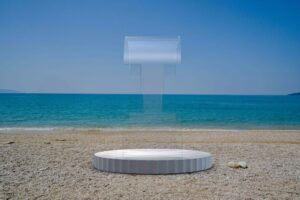
Gill Gatfield, In Absentia, 2023, Ionion Islands UNESCO Geopark. Crystal glass, Acropolis marble, extended reality, 3.53mH x 3m Dia. Photo Chiara Becattini, courtesy and copyright the artist
Sara Buoso: Your digital practice explores the metaverse. What is your focus in this area of investigation?
Gill Gatfield: The metaverse is a world of infinite possibilities, fast being shaped by a brain-based economy, where humans fuel AI datasets. It is also fertile territory to drive equitable outcomes and import humanist values on a global scale. My projects inject human agency and radical consciousness into this equation using extended reality (XR) technologies in sculptures and installations in real-world contexts. The projects are deeply experimental and long-play, and site XR mediums (virtual, augmented and mixed realities) in aesthetic and critical frameworks. My focus is on the dynamic potential of digital sculpture in contemporary life, and its capacity to connect with people in a given place and time. I am interested in a digital art that offers both a magical experience to lose ourselves in and a mechanism for human re-centring. Across this continuum, abstract forms can prompt meta-questions about the digital-human-spirit connection and the role of humanity in a physical-digital Anthropocene.
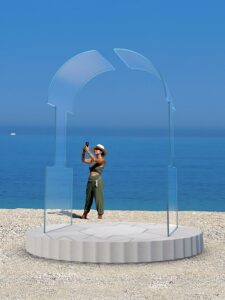
Gill Gatfield, In Absentia, 2023, Ionion Islands UNESCO Geopark. Crystal glass, Acropolis marble, extended reality, 3.53mH x 3m Dia. Photo Chiara Becattini, courtesy and copyright the artist
Can you describe your new digital sculpture, In Absentia, as object and experience?
In Absentia exists as an enigmatic potential. When released, it becomes a performative object. It is made by each person using their mobile phone or tablet to enter augmented reality via my XR app. Viewed through the device’s camera, people can place the sculpture within a physical environment – inside or outside, and move around and through the three-dimensional form, in real time and space. The sense of the sculpture is monumental and surprising, the two crystal glass figures appear unexpectedly like an apparition or a dream. The experience can be personal or communal, where each person sees others encircling and reaching out to their own ‘In Absentia’. Infinite multiples of the virtual sculpture exist, and are captured and shared in images. In physical space, the translucent I-columns arch over three metres high, an architectural story, anchored by a fluted stone base. While the crystalline glass feels futuristic, the grounding is tied to ancient origins – the Ionic column is codified Acropolis marble. The digital presence is simultaneously real and ephemeral. It stands as a virtual ‘being’ with an overriding sense of potential and fragility.
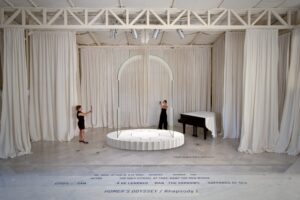
Gill Gatfield, In Absentia, 2023, Homeric Theatre. Photo Chiara Becattini, courtesy and copyright the artist
In Absentia suggests a turning point for what digital practice can do, not just in terms of innovation, but for us as humans.
Where online activity typically isolates us behind a screen, In Absentia invites active engagement in a blended physical-digital world, connected to concrete social realities. The invitation does not cut the umbilical cord to our hand-held mobile device. Instead, it adopts the mobile phone as an extension of the hand and a third eye in contemporary life. The phone camera cements a personal and transactional connection to the sculpture. Here, the device simultaneously documents and internally stores our lived experience in digital clouds, as it externally manifests a digital experience in real-life. In a time of accelerating technologies that dehumanise, and the paradox of AI (which needs human and spatial datasets to build and exceed human brain capacity), In Absentia imagines the inverse. It proposes a vessel for consciousness and agency in a human-digital discourse. The experience of the artwork evokes ideas or feelings of capture or freedom. It offers a face-to-face moment in a transparent cave which could unravel or reset perceptions, as In Absentia mediates between inside and outside, subject and object, human and spirit, other and self. Agency is there for the taking. The digital tools of making are in each person’s hand, the first tool of choice across human evolution; a cup and a fist, it nurtures and fights. As maker and curator, a person touches their screen to etch the digital sculpture in a space. In doing so, they assert a presence and draw on primal and collective memories of mark-making in ancestral pasts. In the present moment, the brain-hand nexus is stimulated, not simulated. The body is set in motion in a pregnant space.
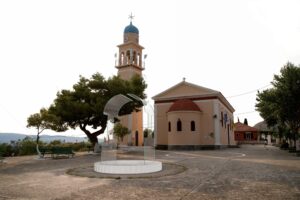
Gill Gatfield, In Absentia, 2023, Farsa Village Kefalonia. Photo Chiara Becattini, courtesy and copyright the artist
You refer to ‘virtual monuments’, in what ways does this concept involve an aesthetics of ephemerality?
In parallel, my art investigates monuments and the ephemeral as modes of practice and philosophies. I am working with these contradictions in terms. Where the monument privileges permanence, the ephemeral is shaped by a dissolved materiality and tenuous existence. The digital is also naturally ephemeral in form and effect. These polar positions of permanence and transience – of the monumental and ephemeral – collide in the virtual monument. The reconciliation of apparently conflicting notions informs my practice. In Absentia sits alongside Native Tongue XR and HALO as ways to negotiate these contradictions through the digital realm. As virtual monuments, they examine the absent presence and over-turn a hallmark of the monument archetype. Historically rigid in materials and form, the monument places a stake in the public’s imagination and on the land. Fixed in place, the object and subject belong to a community, a time, a landscape. Yet, in the very act of commemoration or memorialising one history or reality, other realities are silenced or suppressed. In this sense, the physical monument accentuates that which is not there. In shared space, the virtual monument could be described as state-less. Its designation as monument is personal and discretionary, and shifts depending on individuals’ perceptions, collective experiences, and critical contexts. Its existence and duration are discretionary, fluid, and transient, and in the control of each person’s hands. With potential to manifest in multiple physical realities, a non-partisan virtual monument can remain an open system for diverse narratives.
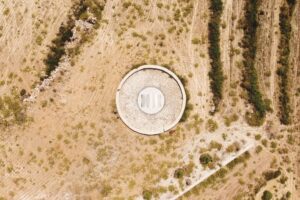
Gill Gatfield, In Absentia, 2023, Ionion Islands UNESCO Geopark. Photo Chiara Becattini, courtesy and copyright the artist
Beyond aesthetics the artworks hold symbolic and political meanings. In which sense are activism and agency engaged in your practice?
I am motivated by critical meta-questions about sustainability, climate change, decolonisation, and equity. These imperatives permeate virtual and physical worlds, and inform my practice and artworks. Purpose-led values are embedded in my modes of working, and brings socio-political content to the work. Activist potential exists also in the locus and presentation of a work. To probe ideas of (im)balance, for example, a physical imprint would be minimal for a work that is monumental in scale and ideas. In my digital work, I am developing the sustainable sculpture. These artworks conserve and elevate precious or rare Earth materials which are closely studied and codified. Abstract forms are cut, carved and moulded in extended reality, eliminating energy-consuming processes of extraction, fabrication, transport, and installation. Audiences perceive these light footprints when activating the sustainable sculpture. It exists as matter in the metaverse.
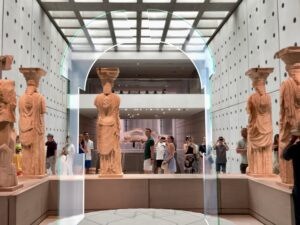
Gill Gatfield, In Absentia, 2023, detail, Acropolis Museum. Photo Gill Gatfield, courtesy and copyright the artist
The symbol ‘I’ repeats in the crystal-glass forms of In Absentia, how does this express meaning in the artwork?
The I-form is multivarious. It is universal (to the extent the English language is pervasive) and personal. It might emerge as a column, number, letter, or torso – a body sans arms and legs. It can signify identity and presence, sentience and omnipotence, birth and death. As text read aloud it is a phonetic ‘eye’ and makes sounds of love and assent; ‘aye’ or ‘āe’, or ‘ai’ – AI. As a pronoun, it projects a Western lens. I is gender-free, political and offers agency to every-one. As an I-beam, it is structural, and when standing, is a stake in the ground. The twin I-forms of In Absentia can invite a rethinking of insider / outsider narratives and states of being, depending on the sculpture’s siting. Activated, for example, in a Greek UNESCO geopark, the ancient home of nymphs, muses and goddesses, the fluctuating figures suggest elusive spirits: in materials, medium, title and form. The curved Ionic base upholds the feminine attributes ascribed to this columnar Order, and grounds the fluid I-figures in a balletic pas de deux. The translucent I’s describe an illusory existence, akin to that of these mythical figures which are obscured or minimised in the chronicles of time. In a digital reimagining, In Absentia places the genesis of these spirit-figures in the palm of every hand.
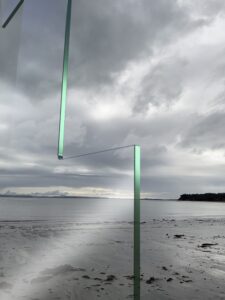
Gill Gatfield, In Absentia, 2023, detail. Photo Gill Gatfield, courtesy and copyright the artist
You have activated In Absentia in the Ionion Island of Kefalonia, the Acropolis Museum Athens, the British Museum in UK, and at Stonehenge. In each setting the work feels site-specific, why is it positioned within these specific contexts.
The digital monument is inherently borderless. It can be a messenger, a salve, or a protagonist in free space. Activated as endless multiples by audiences in curated spaces, the artwork has abundant provenance. In Absentia is on a journey – in itself a form of ephemeral existence, one punctuated by presence and absence in a place. Its inaugural placements are specific contexts where there are communities, mythologies, histories, ecologies, geographies, and social movements that inform this work. Each context potentially binds the object and the subject with the multiple and layered stories of people and place. These are rich grounds for activating a democratic monument. The journey of In Absentia begins at the ancient Acropolis of Athens. Here the virtual structure stands looking up to the Erechtheion, a temple built to honour Athena, a goddess of wisdom and war. This temple was home to a Caryatid and Ionic Column taken by British diplomat Lord Elgin during the Ottoman Empire, and still “preserved” in a backroom at the British Museum, where the Caryatid supports the roof. As a monument or classical statuary, In Absentia embodies and protests these and other losses. Covert activations have followed – inside the Acropolis Museum where a poignant gap marks a space for the missing Caryatid and in the British Museum room where In Absentia arches over the marble figure amidst the revelations of lost and stolen treasures from inside that institution. In the dramatic landscapes and theatres of the Ionion Islands, the site of Homer’s Odyssey, In Absentia conjures epic journeys of crisis and struggle, autonomy and self-determination, transformation and growth. These and new activations are the beginnings of ongoing engagement in meaningful environments for this work.

Gill Gatfield, In Absentia, 2023, Ionion Islands UNESCO Geopark. Photo Chiara Becattini, courtesy and copyright the artist
In a wider view, your practice addresses a third genre of discourse, an approach that is not founded in dichotomies but proposes a unique way to articulate conceptualism and language.
Dichotomies can be dead-ends, they polarise by definition. I’m curious about liminal spaces where meaning might thrive. In recent works, I am exploring silence, as a portal and dialogue, and as rhythm and wave. These and other frequencies are potent spaces for building connections between people, objects and ideas. Each artwork, digital or analog, can be perceived as an extended metaphor informed by the abstract language of of its constituent parts. The work’s enquiry is speculative and remains in process even when the work is released or fixed permanently. I see the artwork as an operating system powered by the matrix of its combined parts: the medium, material, symbol, scale, title, sites and audiences. Each component holds meanings which are specific and dendritic, and will shift depending on cultural contexts and time. Ideas reside also in the inter-disciplinary layers of the subject-object, and can be understood through frameworks such as critical theory, neuroaesthetics, phenomenology, or semiotics – which brings the poetic to the fore. Formal elements alone will not hold the key. The artwork’s ideas are contingent on the unique stories of people and place, and of emotion, senses and memory. As a constant, the artwork transacts with its environment. It displaces or describes a volume of air, and seeks to add something fluent in the atmosphere.
Info:
https://vimeo.com/869784574#t=0

She is interested in the visual, verbal and textual aspects of the Modern Contemporary Arts. From historical-artistic studies at the Cà Foscari University, Venice, she has specialized in teaching and curatorial practice at the IED, Rome, and Christie’s London. The field of her research activity focuses on the theme of Light from the 1950s to current times, ontologically considering artistic, phenomenological and visual innovation aspects.



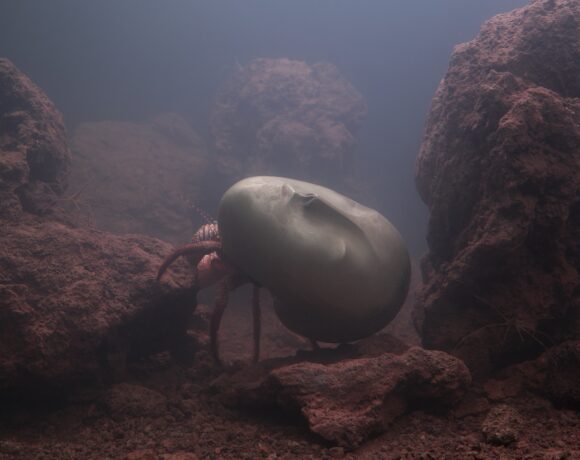
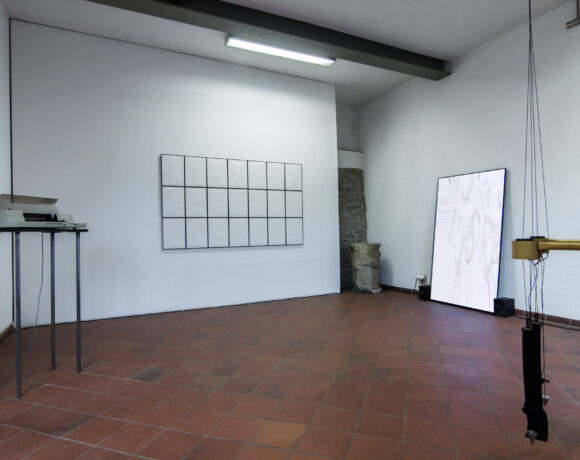

NO COMMENT